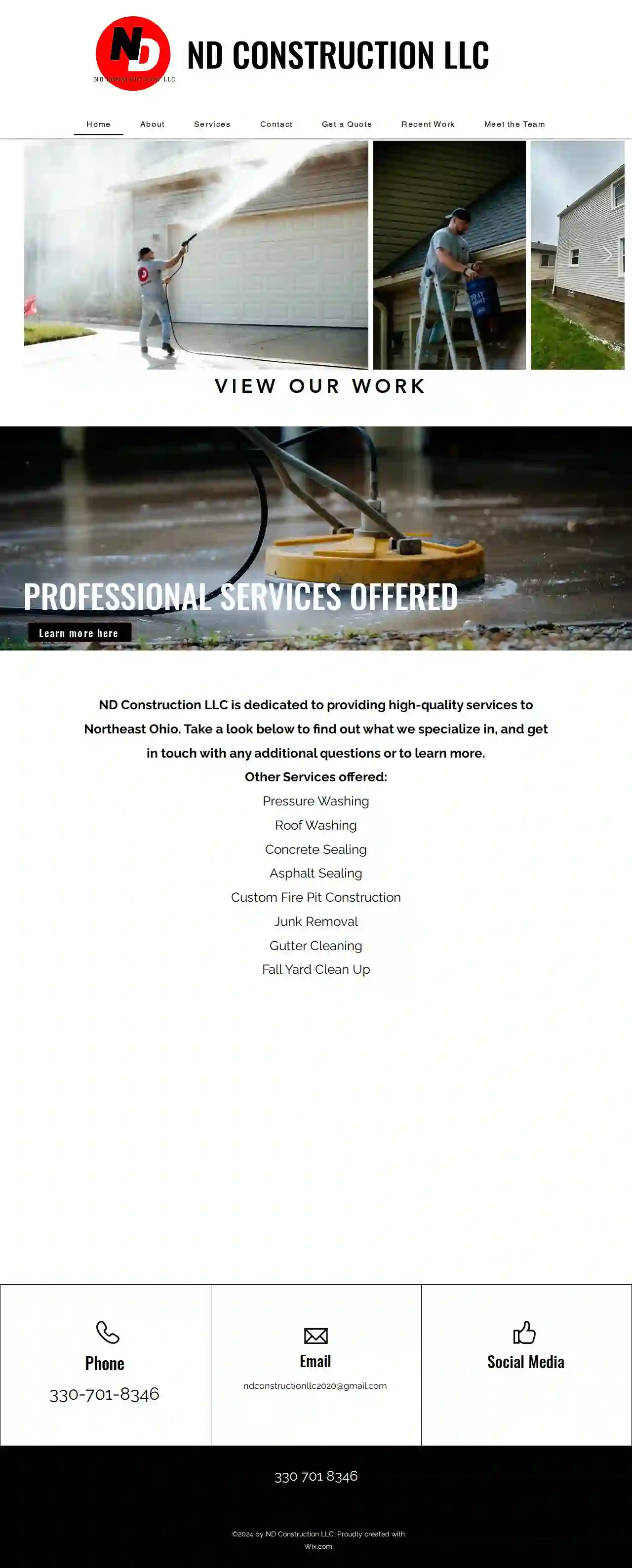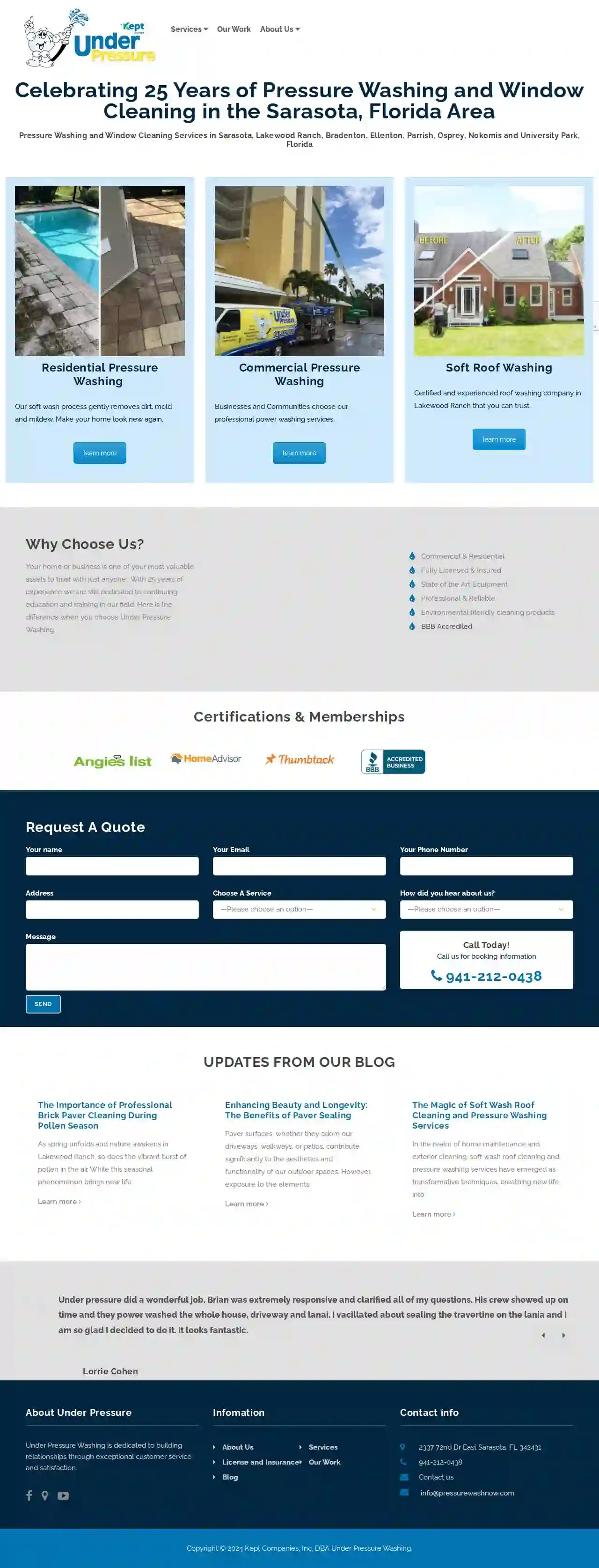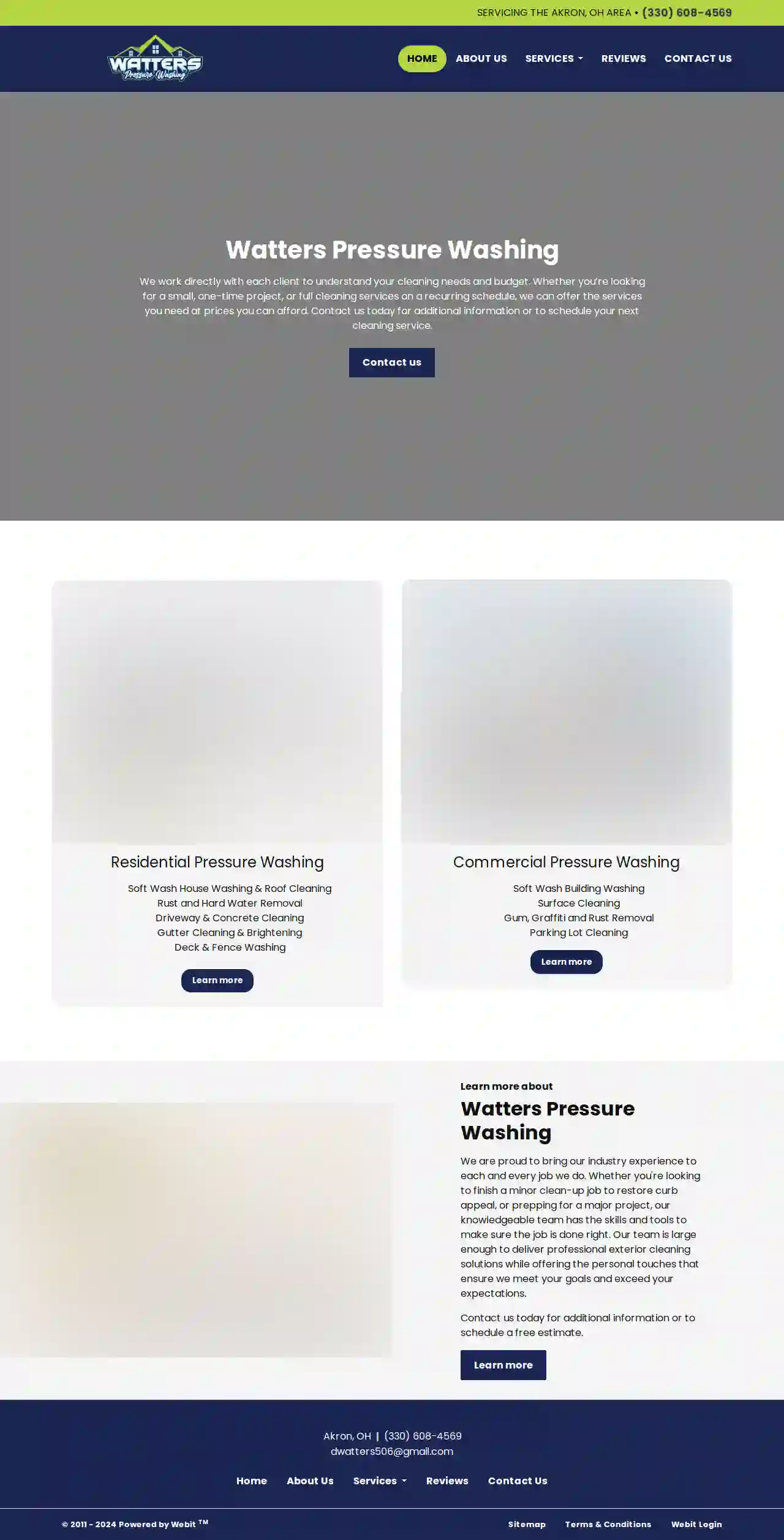Pressure Washing Belpre
Find Power Washing in Belpre
Get multiple Commercial Pressure Washing quotes for your project today! Compare profiles, reviews, accreditations, portfolio, etc... and choose the best service.

Pressure Washing Woodstock
4.34 reviews536 Brooksdale Drive, Woodstock, 30189, USPressure Washing Woodstock is a professional pressure washing company serving Woodstock, GA. We specialize in providing top-quality pressure washing services to residential and commercial properties. Our team of experienced pressure washers uses the best equipment and techniques to remove mold, mildew, dirt, and grime from various surfaces, including stucco, brick, wood, siding, and stone. We pride ourselves on providing exceptional service, ensuring that our customers receive a professional-quality job every time. Whether you need a residential or commercial pressure washing service, we are here to help. Our services include house pressure washing, commercial pressure washing, roof cleaning services, deck and patio cleaning service, driveway and sidewalk cleaning service, fence cleaning service, parking lot pressure washing, and graffiti removal. Contact us today to schedule your appointment and experience the best pressure washing service in Woodstock, GA.
- Services
- Why Us?
- Gallery
Get Quote
J&L Cleaner Homes Pressure washing LLC
533 reviewsAkron, USJ & L Cleaner Homes LLC is a locally owned and operated pressure washing company serving Stow, Cuyahoga Falls, Kent, and all of Northeast Ohio. Founded in 2018 by Josh Hillier, the company was born out of a need for affordable and reliable pressure washing services. Josh noticed that many companies were charging exorbitant prices for pressure washing, so he decided to start his own business and offer competitive rates without compromising on quality. J & L Cleaner Homes specializes in soft wash techniques, which use a gentle combination of pressure and effective soaps to safely remove stains, mold, algae, and moss from a variety of surfaces, including vinyl, aluminum, painted wood siding, concrete, decks, patios, paver stones, and gutters. The company is fully insured and committed to providing exceptional cleaning solutions for both residential and commercial clients. Josh's goal is to provide the same level of service he would expect to receive as a customer, with integrity and professionalism.
- Services
- Why Us?
- Our Team
- Testimonials
- Gallery
Get Quote
SRQ Wash
522 reviewsSarasota, FL, 123 Main St, 34243, USSRQ Wash is a pressure washing and soft washing service provider based in Sarasota, Florida. We use state-of-the-art equipment to deliver lasting results that protect hard surfaces and increase the durability and longevity of your home or office. Our team is committed to providing exceptional service, ensuring customer satisfaction, and maintaining a high level of safety and sanitization. We offer a range of services, including pressure washing, soft washing, roof cleaning, house washing, concrete cleaning, parking lot maintenance, lanai cleaning, pool cage cleaning, paver cleaning, driveway cleaning, building washing, exterior window cleaning, and rust removal. Our goal is to provide a fantastic first impression for your home or business, and we strive to exceed customer expectations.
- Services
- Why Us?
- Testimonials
- Gallery
Get Quote
Perfect Power Wash
4.6Akron, USPerfect Power Wash is a professional power washing company serving Northeast Ohio. They offer a range of services including holiday light installation, house washing, concrete washing and sealing, roof treatment, soft wash services, commercial wash services, annual power washing, brick and stone power wash, and wood power wash. They highlight their team of trained professionals and offer a free quote.
- Services
- Why Us?
- Gallery
Get Quote
Grime Fighter Soft Wash
520 reviews123 Main St, Masury, Ohio, 44446, USGrime Fighter Soft Wash specializes in restoring the beauty and cleanliness of your residential & commercial property. Our services include house washing, deck, driveway, gutter cleaning, roof wash & more.
- Services
- Why Us?
- Accreditations
- Our Team
- Testimonials
- Gallery
Get Quote
Apply Pressure
5172 reviews4031 Colonel Glenn Hwy, Beavercreek Office Suites, Beavercreek, 45431, USWe take substantial pride in our work. It is our goal on every job to ensure every customer we work with is happy with our work.Apply Pressure is a veteran owned and operated business servicing Dayton, Ohio. Our mission is to remind people of their value. To improve Dayton’s character through cleanliness. To inspire discipline and trust in our dreamers that they can succeed and contribute by doing what they love I’m Jeremy Turner. I was born and live right here in Dayton, Ohio. After graduating early from Northmont High School, I joined the U.S. Army on my 17th birthday. While serving my country at the LaPoint US Army Reserve Center in Fairborn, OH, I earned my MBA in International Business from Wright State University. After completing my Army service, I entered the corporate world to gain valuable experience, starting my career at R+L Carriers in Wilmington, Ohio, and then at Chase Bank in Middletown, Ohio. While I appreciated the business skills these positions taught me, I yearned to be an entrepreneur, and I knew I had the knowledge, work ethic, drive, and discipline that I needed to be successful.I started Apply Pressure to create jobs, treat people according to my values, and test my skills to build a business from scratch. Over 500 clients later, I’m proud to say that Apply Pressure is fulfilling our mission of reminding people of their value and cleaning and renewing our city, one job at a time.At Apply Pressure, we serve everyone and support diversity and equality by fostering an environment of respect where individuals are celebrated based on their mindset, unique abilities, personality, teamwork, dedication, and desire to serve their community. Everyone is treated equally in my company regardless of their race, sex, or other identifiable characteristics. I simply reward our team members who succeed in serving our customers to the highest satisfaction levels and who embrace our values of hard work, service, teamwork, and accountability.
- Services
- Why Us?
- Accreditations
- Our Team
- Gallery
Get Quote
ND CONSTRUCTION LLC
510 reviewsAkron, USND Construction LLC is dedicated to providing high-quality services to Northeast Ohio. We finish each project on schedule and with the highest level of quality. With a focus on personalized service, competitive rates and customer satisfaction, we’re always striving to meet and exceed expectations.
- Services
- Why Us?
- Gallery
Get Quote
Under Pressure Washing LLC
4.9200 reviews2337 72nd Dr East, Sarasota, 342431, USUnder Pressure Washing is dedicated to building relationships through exceptional customer service and satisfaction. Celebrating 25 Years of Pressure Washing and Window Cleaning in the Sarasota, Florida Area. Pressure Washing and Window Cleaning Services in Sarasota, Lakewood Ranch, Bradenton, Ellenton, Parrish, Osprey, Nokomis and University Park, Florida.
- Services
- Why Us?
- Testimonials
- Gallery
Get Quote
Watters Pressure Washing
59 reviews418 Meadow Ln, Akron, 44301, USWatters Pressure Washing is a professional contractor offering exterior cleaning and pressure washing services to help remove years of grit, grime, and grease quickly, affordably, and safely. We are dedicated to helping our clients with all sizes of exterior cleaning projects and a variety of pressure washing services. Whether it's residential or commercial building complex washing projects, Watters Pressure Washing is ready for all types of pressure washing needs in Akron, Ohio and surrounding areas. Our team is supplied with the skills and equipment to complete your cleaning projects safely, efficiently, on-time, and on-budget. We are proud to bring our industry experience to each and every job we do. Whether you're looking to finish a minor clean-up job to restore curb appeal, or prepping for a major project, our knowledgeable team has the skills and tools to make sure the job is done right. Our team is large enough to deliver professional exterior cleaning solutions while offering the personal touches that ensure we meet your goals and exceed your expectations.
- Services
- Why Us?
- Our Team
- Testimonials
- Gallery
Get Quote
All-Star SoftWash
536 reviews2830 N Holland Sylvania Rd Suite C, 43615, USAll-Star SoftWash is a top-rated exterior cleaning company based in Toledo, Ohio. We offer a wide range of services including house washing, roof washing, window cleaning, gutter cleaning, and more. Our team is fully insured and licensed, ensuring your property is in good hands. We use the latest and most effective pressure washing equipment and techniques to get your home looking its best. Our goal is to provide exceptional customer service and affordable rates.
- Services
- Why Us?
- Accreditations
- Our Team
- Testimonials
- Gallery
Get Quote
Over 60,241+ Janitorial Services on our platform
Our janitorial contractors operate in Belpre & surroundings!
CleaningMatch has curated and vetted Top Janitorial Services arround Belpre. Find a trustworthy pro today.
Frequently Asked Questions About Pressure Washing
- Annually: Pressure washing your house at least once a year helps remove accumulated dirt, grime, and other contaminants, keeping it looking its best.
- Every 2-3 Years: If you live in an area with high humidity, heavy tree cover, or frequent exposure to pollutants, more frequent pressure washing may be necessary.
- When Visible Dirt and Grime Appear: Address visible dirt, stains, or mold growth promptly to prevent them from becoming more challenging to remove.
- Pressure Washing: If your siding is in good condition but dirty or stained, pressure washing can effectively restore its appearance without the need for painting.
- Painting: If your siding is faded, chipped, peeling, or damaged, pressure washing alone may not be sufficient. Painting provides a fresh coat of protection and a new look.
- Pressure Washing Before Painting: Pressure washing is an essential step before painting, as it removes dirt, grime, and loose paint, creating a clean surface for the new paint to adhere to.
- Experience: 'How long have you been in business, and what types of pressure washing projects do you specialize in?'
- Licensing and Insurance: 'Are you licensed, insured, and bonded? Can I see proof of coverage?'
- Equipment and Techniques: 'What type of pressure washer do you use? What cleaning solutions do you use, and are they safe for my surfaces?'
- Safety Precautions: 'What safety precautions do you take during pressure washing?'
- Surface Preparation: 'Will you need to move any furniture or objects before pressure washing?'
- Water Usage: 'Do you use a water reclamation system or other methods to conserve water?'
- Cleanup: 'How do you handle cleanup after pressure washing?'
- Guarantees: 'Do you offer a satisfaction guarantee?'
- References: 'Can you provide references from previous clients?'
How often should I pressure wash my house?
Regular pressure washing can maintain your home's exterior, extend the lifespan of your siding, and enhance its curb appeal.
What is the difference between pressure washing and soft washing?
Pressure washing uses high-pressure water spray to blast away dirt, grime, and other stubborn contaminants from hard surfaces. It's effective for cleaning driveways, decks, patios, fences, and siding.
Soft washing utilizes low-pressure water combined with specialized cleaning solutions to gently remove dirt, mold, mildew, and algae from delicate surfaces like roofs, siding, and painted surfaces. Soft washing is less abrasive than pressure washing, preventing damage to sensitive materials.
Choosing the appropriate cleaning method depends on the type of surface, its condition, and the desired cleaning outcome. Consult with a professional pressure washing company to determine the best approach for your specific needs.
Is it better to pressure wash or paint my house?
Assess the condition of your siding and your desired outcome to determine whether pressure washing, painting, or a combination of both is the best approach.
What questions should I ask a pressure washing contractor before hiring them?
By asking these questions, you can gather valuable information and choose a pressure washing contractor that meets your requirements.
How often should I pressure wash my house?
- Annually: Pressure washing your house at least once a year helps remove accumulated dirt, grime, and other contaminants, keeping it looking its best.
- Every 2-3 Years: If you live in an area with high humidity, heavy tree cover, or frequent exposure to pollutants, more frequent pressure washing may be necessary.
- When Visible Dirt and Grime Appear: Address visible dirt, stains, or mold growth promptly to prevent them from becoming more challenging to remove.
Regular pressure washing can maintain your home's exterior, extend the lifespan of your siding, and enhance its curb appeal.
What is the difference between pressure washing and soft washing?
Pressure washing uses high-pressure water spray to blast away dirt, grime, and other stubborn contaminants from hard surfaces. It's effective for cleaning driveways, decks, patios, fences, and siding.
Soft washing utilizes low-pressure water combined with specialized cleaning solutions to gently remove dirt, mold, mildew, and algae from delicate surfaces like roofs, siding, and painted surfaces. Soft washing is less abrasive than pressure washing, preventing damage to sensitive materials.
Choosing the appropriate cleaning method depends on the type of surface, its condition, and the desired cleaning outcome. Consult with a professional pressure washing company to determine the best approach for your specific needs.
Is it better to pressure wash or paint my house?
- Pressure Washing: If your siding is in good condition but dirty or stained, pressure washing can effectively restore its appearance without the need for painting.
- Painting: If your siding is faded, chipped, peeling, or damaged, pressure washing alone may not be sufficient. Painting provides a fresh coat of protection and a new look.
- Pressure Washing Before Painting: Pressure washing is an essential step before painting, as it removes dirt, grime, and loose paint, creating a clean surface for the new paint to adhere to.
Assess the condition of your siding and your desired outcome to determine whether pressure washing, painting, or a combination of both is the best approach.
What questions should I ask a pressure washing contractor before hiring them?
- Experience: 'How long have you been in business, and what types of pressure washing projects do you specialize in?'
- Licensing and Insurance: 'Are you licensed, insured, and bonded? Can I see proof of coverage?'
- Equipment and Techniques: 'What type of pressure washer do you use? What cleaning solutions do you use, and are they safe for my surfaces?'
- Safety Precautions: 'What safety precautions do you take during pressure washing?'
- Surface Preparation: 'Will you need to move any furniture or objects before pressure washing?'
- Water Usage: 'Do you use a water reclamation system or other methods to conserve water?'
- Cleanup: 'How do you handle cleanup after pressure washing?'
- Guarantees: 'Do you offer a satisfaction guarantee?'
- References: 'Can you provide references from previous clients?'
By asking these questions, you can gather valuable information and choose a pressure washing contractor that meets your requirements.